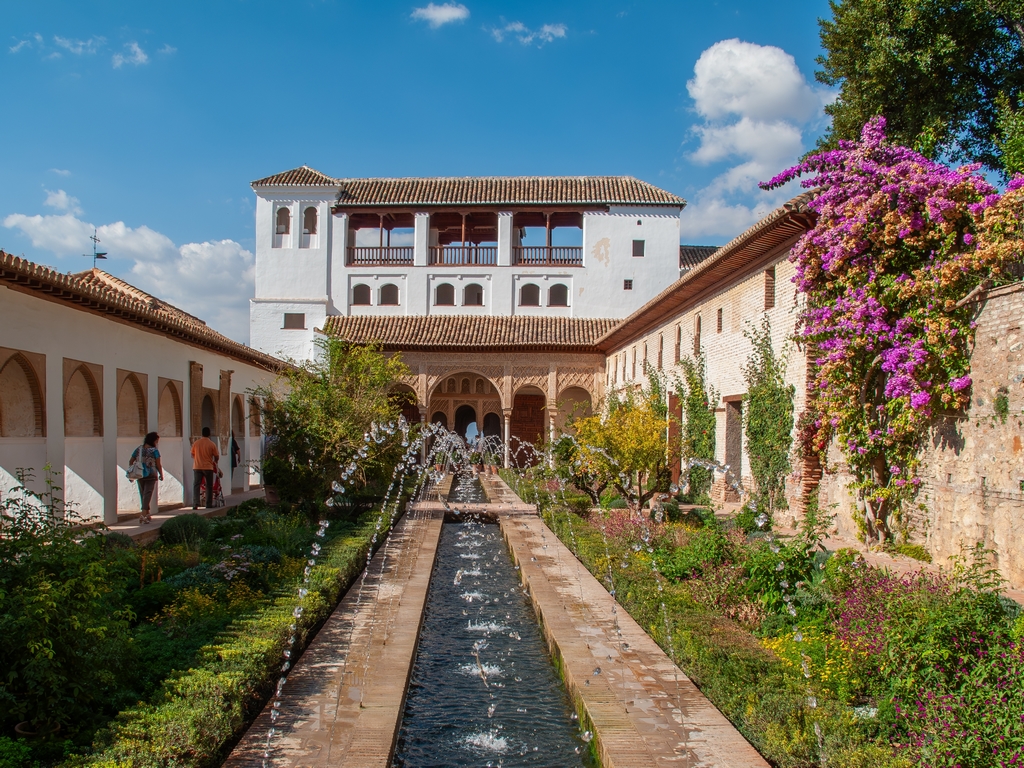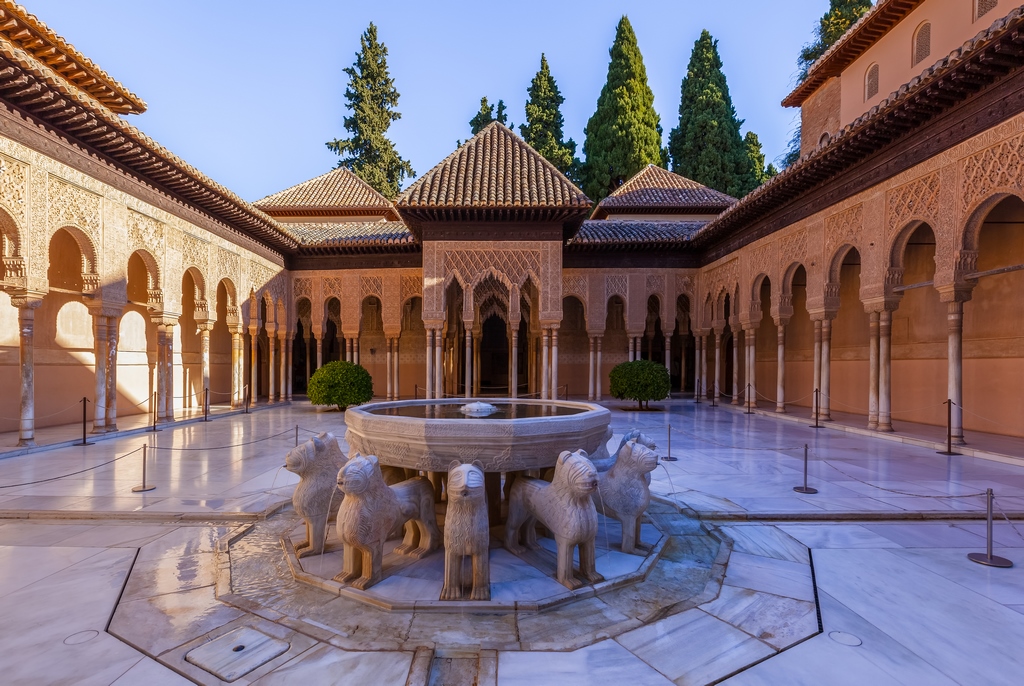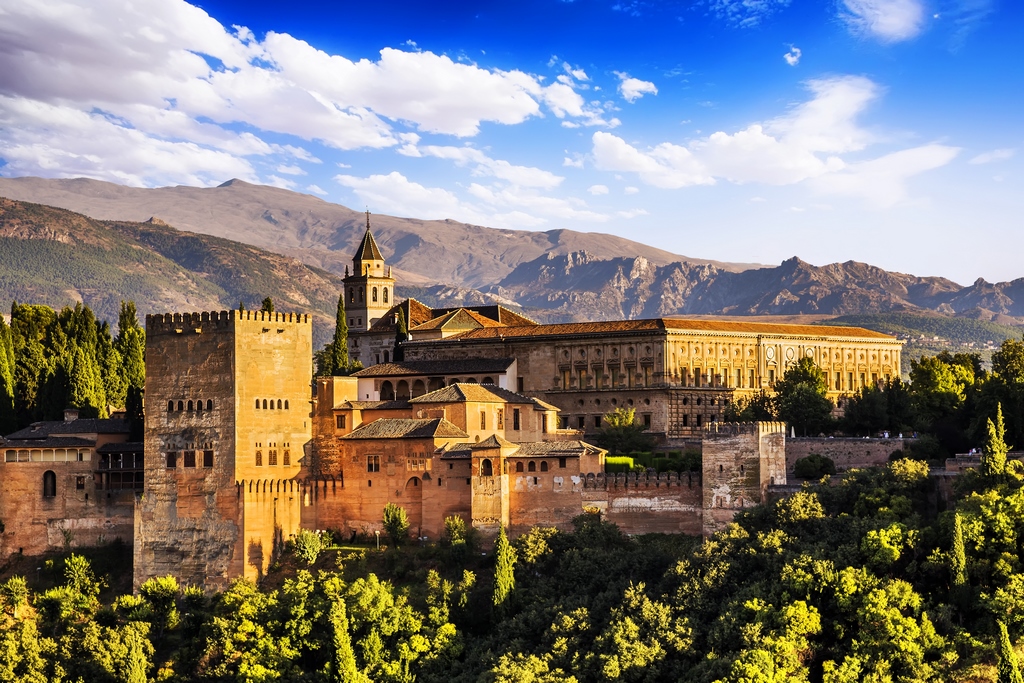The Alhambra: A Testament to Moorish Splendor
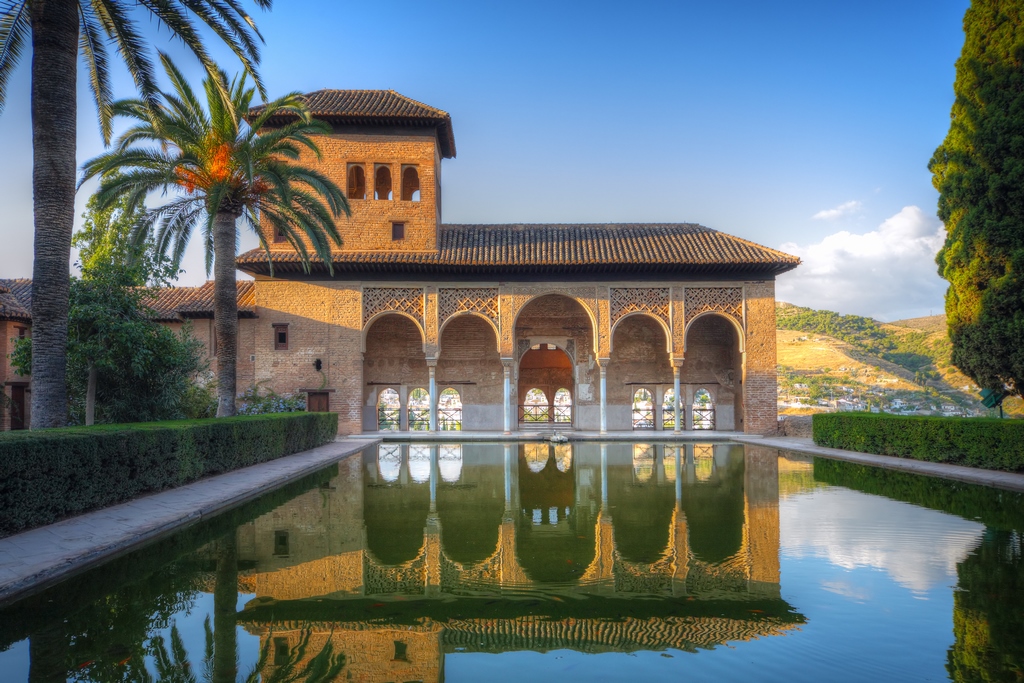

Traveling to the Alhambra in Granada, Spain, is a journey into a world of stunning Moorish architecture, lush gardens, complex history, and water. The sprawling complex is rich with details that evoke the property’s storied past, a place that rewards curiosity and provides inspiration for modern architects, watershapers, artists, and dreamers the world over.
By Eric Herman
A majestic palace and fortress complex perched atop the hills of Granada, Spain, the Alhambra stands as a symbol of the rich and diverse history of the Iberian Peninsula. It is a timeless testament to the artistic and cultural achievements of the Nasrid dynasty and the broader legacy of Spain’s Islamic past. It is a rewarding place to visit and linger, stimulating to both the senses and intellect.
The UNESCO World Heritage site with its sprawling grounds and breathtaking views of the Sierra Nevada mountains, was originally constructed as a fortress in 889 AD , and later converted into a royal palace in the mid-13th century. More a collection of properties than a singular establishment, the Alhambra encompasses a kaleidoscopic collection of artistic and architectural traditions and details.
Today, visitors explore the intricately decorated Nasrid Palaces, the tranquil Generalife gardens, and the imposing Alcazaba fortress. The properties’ complex design, innovative use of water, and harmonious integration with the natural landscape, make the Alhambra a masterpiece of architecture and landscape architecture.
Visitors can spend hours or even days wandering the structures and gardens, getting lost in the intricacy, detail and timeless sophistication.
A RICH HISTORY
The Alhambra’s cultural significance transcends its historical context, symbolizing the coexistence of different cultures and the enduring power of human creativity.
Muhammad I, the founder of the Nasrid dynasty, initiated the construction of the Alhambra in the 13th century, transforming the existing fortress into a grand palace complex. The Alhambra’s name comes from the Arabic word Qal’at al-Hamra, which means “red fort,” referring to the structures’ rubicund walls.
Over the next two centuries, successive rulers expanded and embellished the Alhambra, creating a harmonious blend of Islamic art and architecture featuring arches, plazas, verandas and gardens, and numerous watershapes. The complex reached its zenith under the reign of Yusuf I and Muhammad V in the 14th century, who commissioned many of the iconic structures and gardens that now define the property and its legacy.
In 1492, the Alhambra witnessed an historic turning point when the Catholic Monarchs, Ferdinand and Isabella, conquered Granada, marking the end of Muslim rule in Spain.
The property was repurposed as a royal court, and subsequent alterations were made to reflect Christian influences. Despite these changes, the core of the Nasrid architecture remained largely intact, preserving the essence of its Islamic heritage.
DESIGN AND AESTHETIC
Now covering 35 acres in its modern form, the architectural design of the Alhambra is a testament to the ingenuity and creativity of the Nasrid artisans. The complex is characterized by its intricate stucco work, geometric patterns, and calligraphy. The Alhambra’s layout is organized around a series of courtyards, each serving as a focal point for the surrounding structures, creating an almost endless array of cross-connecting viewpoints and reflections.
The Mexuar Hall, the oldest part of the palace, served as a council chamber and a place for administering justice. Simple yet elegant, the hall’s design features a mix of Islamic and Christian elements, reflecting the transition period during its construction. The Comares Palace, the official residence of the Nasrid sultans, is renowned for its stunning façade adorned with intricate tilework and lyrical arabesques.
The Hall of the Ambassadors, located within the Comares Palace, is one of the most impressive spaces in the Alhambra. Its wooden ceiling, decorated with a multitude of stars, symbolizes the heavens and reflects the Nasrid’s astronomical interests. The hall’s walls are adorned with intricate stucco work and inscriptions from the Quran, emphasizing the spiritual and cultural values of the Nasrid dynasty.
The Palace of the Lions, another architectural masterpiece, is named after the central fountain supported by twelve marble lions. This palace exemplifies the Nasrid’s advanced engineering skills and artistic sensibilities. The Hall of the Abencerrajes and the Hall of the Two Sisters within the Palace of the Lions are renowned for their muqarnas (honeycomb) vaulting, creating a mesmerizing play of light and shadow.
Beyond its architectural splendor, the Alhambra played a crucial role as a cultural and intellectual center. It was a hub for scholars, poets, and artists who contributed to the flourishing of Islamic culture in medieval Spain.
The Alhambra’s libraries housed numerous manuscripts on various subjects, including astronomy, mathematics, and literature, facilitating the exchange of knowledge between the Islamic world and Europe.
The Alhambra also symbolizes the coexistence of different cultures and religions. Despite the eventual Christian conquest, the Alhambra’s Islamic heritage was preserved and celebrated.
This cultural blending is evident in the architectural modifications made by the Catholic Monarchs, who respected and integrated elements of Islamic art into their additions to the complex.
WATER & LANDSCAPE
Water plays a central role in the design and symbolism of the Alhambra. The Nasrid architects ingeniously incorporated water features throughout the complex, creating a serene, balanced and harmonious environment. The use of water not only served practical purposes but also held profound symbolic significance.
The Court of the Myrtles, with its large reflective pool, exemplifies the Nasrid’s mastery of hydraulic engineering. The pool’s still waters create a mirror-like surface, reflecting the surrounding architecture and enhancing the sense of tranquility. The delicate balance between water and architecture in this courtyard evokes a sense of paradise, a common theme in Islamic Garden design.
The Generalife, the Alhambra’s summer palace and gardens, is another masterpiece of landscape architecture and historic watershaping. Located on a hill adjacent to the main complex, the Generalife offers breathtaking views of the Alhambra and the city of Granada. Its terraced gardens — adorned with fountains, water channels, and lush vegetation — exemplify the Nasrid’s appreciation for nature and their ability to create idyllic landscapes.
The Acequia Court, one of the highlights of the Generalife, features a long pool flanked by flowerbeds and pavilions. The sound of flowing water, from the numerous fountains and water jets, adds to the sensory experience creating a peaceful retreat from the bustling palace complex.
The careful arrangement of plants and water elements in Generalife reflects the Nasrid’s knowledge of horticulture and their desire to recreate the gardens of paradise.
RESTORING & CONSERVING
Over the centuries, the Alhambra has faced numerous challenges, including neglect, natural disasters, and human interventions. However, extensive restoration and conservation efforts have been undertaken at varying intervals in its history to preserve its architectural and cultural heritage.
One of the earliest restoration initiatives was undertaken by the architect Leopoldo Torres Balbás in the early 20th century. His work focused on preserving the original Nasrid elements while removing later additions that compromised the integrity of the complex. Balbás’s meticulous approach set a precedent for future restoration projects, emphasizing the importance of authenticity and historical accuracy.
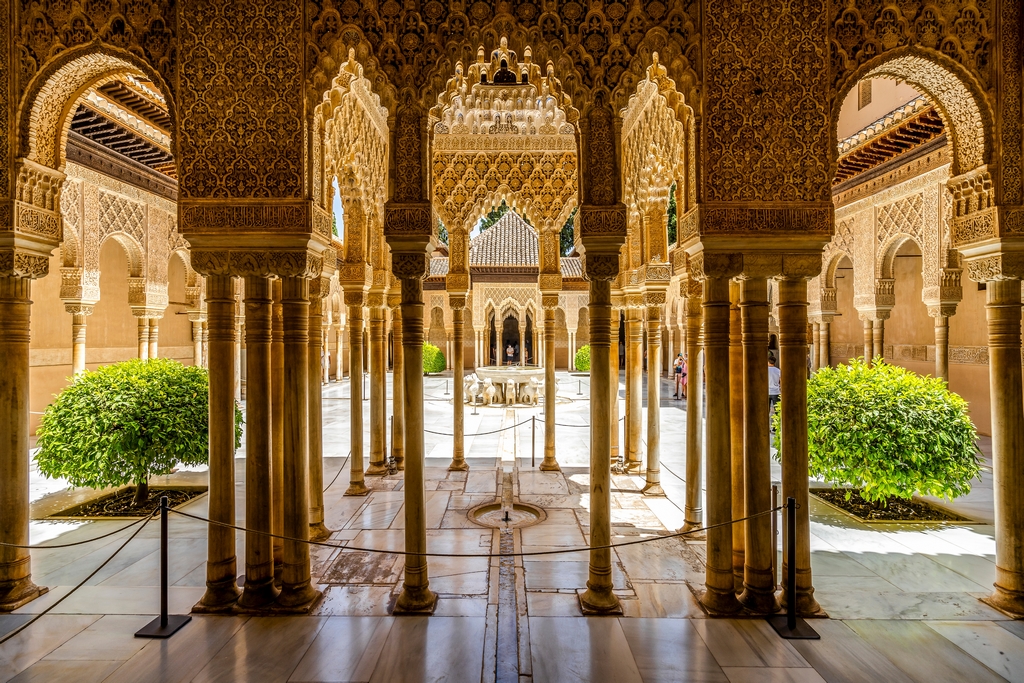
In recent decades, advanced conservation techniques and technologies have been employed to address the challenges of preserving the Alhambra. Structural reinforcements, climate control measures, and the use of non-invasive cleaning methods have been implemented to safeguard the delicate stucco work, tile mosaics, and wooden ceilings.
These efforts have been guided by a commitment to maintaining the Alhambra’s historical and artistic integrity.
International cooperation and funding have also played a significant role in the conservation of the Alhambra. Organizations such as UNESCO and the World Monuments Fund have provided financial support and expertise to ensure the sustainability of restoration projects.
The Alhambra was designated a UNESCO World Heritage Site in 1984, recognizing its universal value and the need for its protection.
INTO THE FUTURE
As one of the most visited cultural sites in Spain, the Alhambra faces the ongoing challenge of balancing tourism with preservation. The influx of visitors poses a risk to the fragile structures and delicate decorations of the complex. To address this, stringent measures have been implemented to regulate visitor numbers and ensure responsible tourism practices.
The Patronato de la Alhambra y Generalife, the organization responsible for managing the site, has developed comprehensive conservation and visitor management plans. These plans include limiting the number of daily visitors, implementing guided tours to control access to sensitive areas, and promoting educational programs to raise awareness about the significance of the Alhambra’s heritage.
Future initiatives also focus on enhancing the visitor experience while preserving the site’s authenticity. Digital technologies, such as virtual reality and augmented reality, are being explored to provide immersive and informative experiences without compromising the physical integrity of the complex. These technologies offer new ways to engage with the Alhambra’s history and architecture, making it accessible to a global audience.
Additionally, ongoing research and archaeological investigations continue to uncover new insights into the Alhambra’s history and construction. These discoveries contribute to a deeper understanding of the Nasrid dynasty and their cultural contributions. The integration of new findings into restoration projects ensures that the Alhambra’s story is continually enriched and accurately represented.
Through meticulous restoration and conservation efforts, the Alhambra has been preserved for future generations to appreciate and admire. As we look to the future, it is imperative to continue these efforts, ensuring that the Alhambra remains a source of inspiration and a bridge between past and present.
The Alhambra’s enduring allure lies not only in its physical beauty but also in its ability to connect us with the rich tapestry of history and culture that shaped its creation.
References: Alhambra | Palace, Fortress, Facts, Map, & Pictures | Britannica, https://www.alhambra.org/en/alhambra-history.html, https://www.oxfordbibliographies.com, “Decoding the secret messages of Spain’s Alhambra palace”, www.elpais.com, https://www.history.com/topics/landmarks/alhambra,
Photos: Opening image by Kutlayev Dimitry | Shutterstock, second photo by Clive Platter | Shutterstock, third photo by Liquid Studios | Shutterstock, fourth photo by Sopotnicki | Shutterstock, final photo by Juan Carlos Munoz | Shutterstock.










